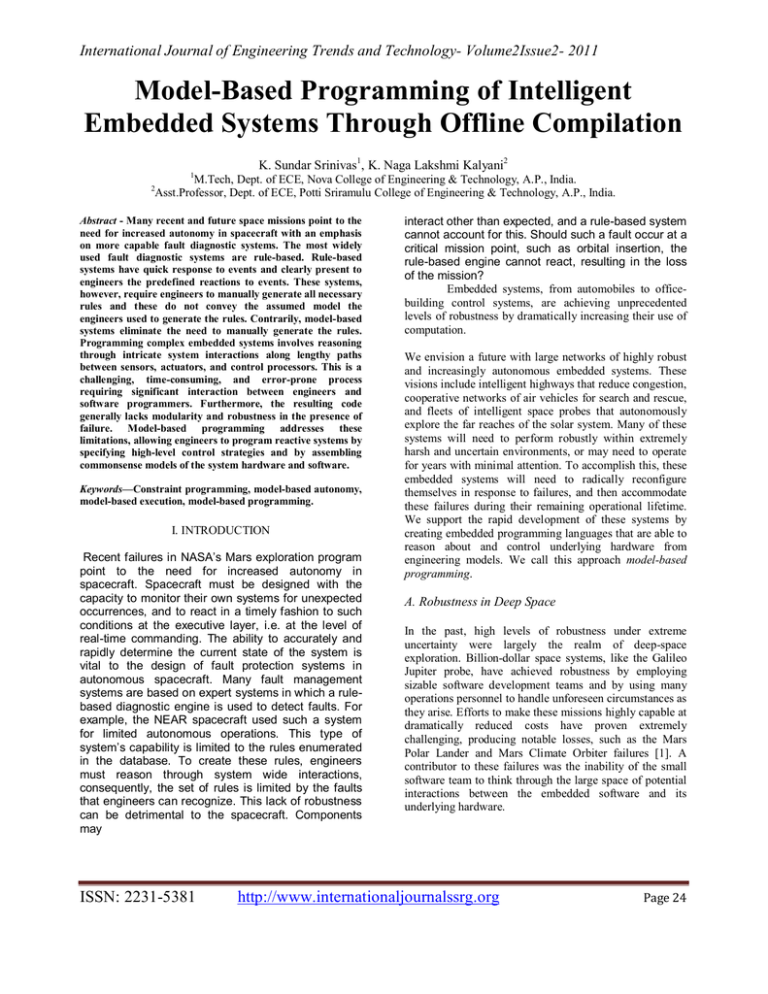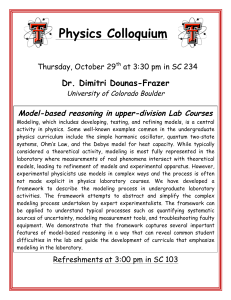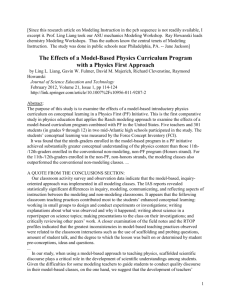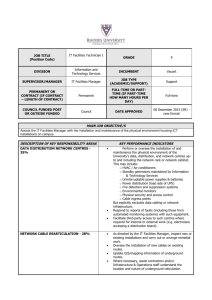Model-Based Programming of Intelligent Embedded Systems Through Offline Compilation
advertisement

International Journal of Engineering Trends and Technology- Volume2Issue2- 2011
Model-Based Programming of Intelligent
Embedded Systems Through Offline Compilation
K. Sundar Srinivas1, K. Naga Lakshmi Kalyani2
1
M.Tech, Dept. of ECE, Nova College of Engineering & Technology, A.P., India.
Asst.Professor, Dept. of ECE, Potti Sriramulu College of Engineering & Technology, A.P., India.
2
Abstract - Many recent and future space missions point to the
need for increased autonomy in spacecraft with an emphasis
on more capable fault diagnostic systems. The most widely
used fault diagnostic systems are rule-based. Rule-based
systems have quick response to events and clearly present to
engineers the predefined reactions to events. These systems,
however, require engineers to manually generate all necessary
rules and these do not convey the assumed model the
engineers used to generate the rules. Contrarily, model-based
systems eliminate the need to manually generate the rules.
Programming complex embedded systems involves reasoning
through intricate system interactions along lengthy paths
between sensors, actuators, and control processors. This is a
challenging, time-consuming, and error-prone process
requiring significant interaction between engineers and
software programmers. Furthermore, the resulting code
generally lacks modularity and robustness in the presence of
failure. Model-based programming addresses these
limitations, allowing engineers to program reactive systems by
specifying high-level control strategies and by assembling
commonsense models of the system hardware and software.
Keywords—Constraint programming, model-based autonomy,
model-based execution, model-based programming.
I. INTRODUCTION
Recent failures in NASA’s Mars exploration program
point to the need for increased autonomy in
spacecraft. Spacecraft must be designed with the
capacity to monitor their own systems for unexpected
occurrences, and to react in a timely fashion to such
conditions at the executive layer, i.e. at the level of
real-time commanding. The ability to accurately and
rapidly determine the current state of the system is
vital to the design of fault protection systems in
autonomous spacecraft. Many fault management
systems are based on expert systems in which a rulebased diagnostic engine is used to detect faults. For
example, the NEAR spacecraft used such a system
for limited autonomous operations. This type of
system’s capability is limited to the rules enumerated
in the database. To create these rules, engineers
must reason through system wide interactions,
consequently, the set of rules is limited by the faults
that engineers can recognize. This lack of robustness
can be detrimental to the spacecraft. Components
may
ISSN: 2231-5381
interact other than expected, and a rule-based system
cannot account for this. Should such a fault occur at a
critical mission point, such as orbital insertion, the
rule-based engine cannot react, resulting in the loss
of the mission?
Embedded systems, from automobiles to officebuilding control systems, are achieving unprecedented
levels of robustness by dramatically increasing their use of
computation.
We envision a future with large networks of highly robust
and increasingly autonomous embedded systems. These
visions include intelligent highways that reduce congestion,
cooperative networks of air vehicles for search and rescue,
and fleets of intelligent space probes that autonomously
explore the far reaches of the solar system. Many of these
systems will need to perform robustly within extremely
harsh and uncertain environments, or may need to operate
for years with minimal attention. To accomplish this, these
embedded systems will need to radically reconfigure
themselves in response to failures, and then accommodate
these failures during their remaining operational lifetime.
We support the rapid development of these systems by
creating embedded programming languages that are able to
reason about and control underlying hardware from
engineering models. We call this approach model-based
programming.
A. Robustness in Deep Space
In the past, high levels of robustness under extreme
uncertainty were largely the realm of deep-space
exploration. Billion-dollar space systems, like the Galileo
Jupiter probe, have achieved robustness by employing
sizable software development teams and by using many
operations personnel to handle unforeseen circumstances as
they arise. Efforts to make these missions highly capable at
dramatically reduced costs have proven extremely
challenging, producing notable losses, such as the Mars
Polar Lander and Mars Climate Orbiter failures [1]. A
contributor to these failures was the inability of the small
software team to think through the large space of potential
interactions between the embedded software and its
underlying hardware.
http://www.internationaljournalssrg.org
Page 24
International Journal of Engineering Trends and Technology- Volume2Issue2- 2011
For example, consider the leading hypothesis for
the cause of the Mars Polar Lander failure. Mars Polar
Lander used a set of Hall Effect sensors in its legs to detect
touchdown. These sensors were watched by a set of
software monitors, which were designed to turn off the
engine when triggered. As the lander descended into the
Mars atmosphere, it deployed its legs. At this point it is
most likely that the force of deployment produced a noise
spike on the leg sensors, which was latched by the software
monitors. The lander continued to descend, using a laser
altimeter to detect distance to the surface. At an altitude of
approximately 40 m, the lander began polling its leg
monitors to determine touchdown. It would have
immediately read the latched noise spike and shut down its
engine prematurely, resulting in the spacecraft plummeting
to the surface from 40 m [2].
B. A MODEL-B ASED PROGRAMMING EXAMPLE
Model-based programming enables a programmer to focus
on specifying the desired state evolutions of the system.
For example, consider the task of inserting a spacecraft into
orbit around a planet. Our spacecraft includes a science
camera and two identical redundant engines (Engines A
and B), as shown in Fig. 3. An engineer thinks about this
maneuver in terms of state trajectories:
novel failures as they arise. This is essential for achieving
high levels of robustness.
2. MINI-ME
Mini-ME differs from previous model-based fault
monitoring systems by guaranteeing run time
performance. Through model compilation and offline
deduction, Mini-ME combines the benefits of the rule
based system’s real time performance guarantees
and the model-based fault protection system’s
capability to reason on models.
2.1 Example System
The diagnostic ability of Mini-ME will be demonstrated
in the following sections using a simplified schematic
of a monopropellant propulsion system used for
attitude control in the NEAR spacecraft, shown in
Figure 2.
Heat up both engines (called standby mode). Meanwhile,
turn the camera off, in order to avoid plume contamination
Figure 2: Monopropellant Propulsion System
Schematic
Fig. 3 Simple spacecraft for the orbital insertion
scenario. Initial state (left) and goal state (right) are
depicted.
When both are accomplished, thrust one of the two
engines, using the other engine as backup in case of
primary engine failure.
This specification is far simpler than a control
program that must turn on heaters and valve drivers, open
valves and interpret sensor readings for the engines shown
in the figure. Thinking in terms of more abstract hidden
states makes the task of writing the control program much
easier and avoids the error-prone process of reasoning
through low-level system interactions. In addition, it gives
the program’s execution kernel the latitude to respond to
ISSN: 2231-5381
The propulsion system comprises two overall
subsystems, the tank of hydrazine and its associated
pressure transducer, and the hydrazine thruster made
up of the solenoid valve, catalyst bed and physical
thruster. An inertial sensor is included in the system
for thrust observation.
The hydrazine thruster is made up of two main
components, the solenoid valve and the catalyst bed.
The solenoid valve controls the hydrazine flow into
the catalyst bed. This is accomplished by applying an
electric current to the valve to open it, otherwise it will
remain closed. Downstream of the solenoid valve is
the catalyst bed, which is needed for combustion.
Over time, catalyst can be lost through various
mechanisms, such as pieces breaking off due to
temperature variations. This will cause a reduction in
thrust from the hydrazine thruster, causing the inertial
sensor to observe that the thrust is off. In the case
http://www.internationaljournalssrg.org
Page 25
International Journal of Engineering Trends and Technology- Volume2Issue2- 2011
that the ACS operates nominally, the inertial sensor’s
reading will be discretized as on.
We start by specifying the two components of a model
based program for orbital insertion: the control program
and plant model. We then describe the execution of the
program under nominal and failure situations.
A. Control Program
The RMPL control program, shown in Fig. 4, encodes the
informal specification we gave previously as a set of state
trajectories. The specific RMPL constructs used in the
program are introduced in Section IV. Recall that to
perform orbital insertion, one of the two engines must be
fired. We start by concurrently placing the two engines in
the standby state and by shutting off the camera. This is
performed by lines 3–5, where commas at the end of each
line denote parallel composition. We then fire an engine,
choosing to use Engine A as the primary engine (lines 6–9)
and Engine B as a backup, in the event that Engine A fails
to fire correctly (lines 10–11). Engine A starts trying to fire
as soon as it achieves standby and the camera is off (line
7), but aborts if at any time Engine A is found to be in a
failure state (line 9). Engine B starts trying to fire only if
Engine A has failed, B is in standby, and the camera is off
(line 10). Several features of this control program reinforce
our earlier points. First, the program is stated in terms of
state assignments to the engines and camera, such as
“EngineB = Firing.” Second, these state assignments
appear both as assertions and as execution conditions. For
example, in lines 6–9, “EngineA = Firing” appears in an
assertion (line 8), while “EngineA = Standby,” “Camera =
Off,” and “EngineA = Failed” appear in execution
conditions (lines 7 and 9). Third, none of these state
assignments are directly observable or controllable, only
shutter position and acceleration may be directly sensed,
and only the flight computer command may be directly set.
Finally, by referring to hidden states directly, the RMPL
program is far simpler than a corresponding program that
operates on sensed and controlled variables. The added
complexity of the latter program is due to the need to fuse
sensor information and generate command sequences under
a large space of possible operation and fault scenarios.
1 OrbitInsert()::{
2 do {
3 EngineA=Standby,
4 EngineB=Standby,
5 Camera=Off,
6 do {
7 when EngineA=Standby ^ Camera=Off
8 donext EngineA=Firing
9 } watching EngineA=Failed,
10 when EngineA=Failed ^ EngineB=Standby ^
Camera=Off
11 donext EngineB=Firing
12 } watching EngineA=Firing v EngineB=Firing
13 }
Fig. 4 RMPL control program for the orbital insertion
scenario.
III. RULE SYSTEM ANALYSIS
A comparison to a real system is the best validation
for the Mini-ME fault diagnosis tool. For verification, a
NEAR-like power system and its associated rules
were analyzed to develop appropriate Mini-ME
models to obtain diagnoses of particular faults. These
rules have several characteristics relating to Mini-ME,
the first being the dependency on time. In all of the
rules, the observation must be made for a certain
length of time before it is triggered. This dependency
is moved outside of Mini-ME through the use of the
monitors. Monitors can be designed with a counter
that is incremented when an observation falls in a
certain range, such as if the charger current exceeds
0.8 A. Only when the counter reaches a certain value,
corresponding to 10 seconds for rule 3, then would
the monitor send the observation that the charger
current is “high”. This use of discretization allows the
modeling to be more intuitive and understandable as
the model is now specified in a more qualitative way.
B. Plant Model
The plant model is used by a model-based executive to map
queried and asserted states in the control program to sensed
variables and control sequences, respectively, in the
physical plant. The plant model is built from a set of
component models. Each component is represented by a set
of component modes, a set of constraints defining the
behavior within each mode, and a set of probabilistic
transitions between modes. The component automata
operate concurrently and synchronously.
ISSN: 2231-5381
Table 2. NEAR-like Power Storage System Rules
http://www.internationaljournalssrg.org
Page 26
International Journal of Engineering Trends and Technology- Volume2Issue2- 2011
No.
1
2
3
4
5
Symptom
(Battery Current > 0.6A)
For 60 sec
(Redundant battery
charger is ON) for 5 sec
(Charger current > 0.8 A)
for 10 sec
(Charger current > 0.07A)
and (Bus Voltage > 24 V)
for 10 sec
(Battery Temp > 30 C) for
1 hour
Recovery Action
Turn off the charger
stop rules 2 and 3
Switch to the redundant
charger, and disengage
the primary.
Same recovery as rule 2.
Switch to the redundant
charger and turn its
trickle charge on
A second characteristic of a NEAR-like rule is that
different symptoms can lead to the same recovery
action, such as the conditions for switching to the
redundant charger (rules 3 and 4). These types of
rule combinations may have the same resulting
action, but lead to a different state for the component.
Hidden in these rules then is the state of the power
system that the engineer had to determine. For
instance, in the case of rule 3, this would mean that
the charger has become broken in some way, thus
identifying the state, and the model of this mode
would come from these symptoms.
Mini-ME has also been used as a tool to
understand model compilation techniques and its
applications. Other such applications that use this
technique include a mode estimation capability for the
Reactive Model based Programming Language
(RMPL) [3], and a reactive planning system, Burton
[4].
IV. CONCLUSION
Fault protection in spacecraft is a must as missions
venture further into space and space systems
increase in complexity. The necessity of a system that
can perform this fault diagnosis in real time is then a
key component. The Mini-ME fault protection system
has been shown to meet this goal without any loss of
information from a rule-based system. The utilization
of system models in Mini-ME allows it to perform
diagnosis of components. A model-based approach
has
many
benefits
including
reusability,
compositionality and specification of intuitive models.
The use of these models to perform reasoning and
deduction has been shifted to an offline operation, an
approach that differs from previous systems such as
Sherlock and Livingstone. This offline compilation of
the models to rules, called dissents, allows Mini-ME
to perform fast diagnosis of faults online. Using these
ISSN: 2231-5381
models and observations from the system, Mini-ME
generates a diagnosis of the system’s components
using a best first search to generate the most likely
diagnosis. This diagnosis gives the state of the
system, which is not available in
a rule-based system. In rule-based systems, the
mapping from symptoms to recovery action is
apparent, but not the mapping from symptoms to the
system state. Making this step explicit leads to rules
that are easier to analyze for completeness, and a
rule set smaller in size. In the case of the example
system in section 2, it requires only 6 dissents to
represent the faults, whereas a rule-based system
would require 32 rules to represent all of the possible
faults. These characteristics lead to more reliable fault
protection as it makes the process of rule generation
modular by using models of the system, monitors that
discretized observations and repair actions based on
the diagnoses, all of which are designed by the
engineer in a clear manner. A key benefit of the MiniME system and the use of associated repair
manager, aside from the model-based approach, is
that they give the spacecraft the ability to remain
operational in the face of component failures. This
ability is crucial as space exploration expands. The
same individuals who designed the spacecraft may
not be around when it lands, which necessitates fault
diagnosis ability.
Acknowledgment
I am thankful to my Guide Miss. K. Naga Lakshmi
Kalyani Asst.Professor Dept.of ECE for her valuable
suggestion to complete my thesis paper in intime.
REFERENCES
[1] T. Young et al.. (2000) Report of the Mars Program Independent
Assessment Team. NASA, Washington, DC. [Online] Available:
http://www.nasa.gov/newsinfo/marsreports.html
[2] J. Casani et al., “Report on the Loss of the Mars Polar Lander and
Deep Space 2 Missions,” NASA Jet Propulsion Laboratory, Pasadena,
CA, JPL D-18 709, 2000.
[3] B. Williams and P. Nayak. 1997. “A Reactive Planner for a
Model-based Executive.” In Proceedings of the International Joint
Conference on Artificial Intelligence (IJCAI-97).
[4] B. Williams, S. Chung, and V. Gupta. Mode Estimation of
Model-based Programs: “Monitoring Systems with Complex
Behavior,” To appear in Proceedings of the International Joint
Conference on Artificial Intelligence, Seattle,WA.2001.around when it
lands, which necessitates fault diagnosis ability.
http://www.internationaljournalssrg.org
Page 27






